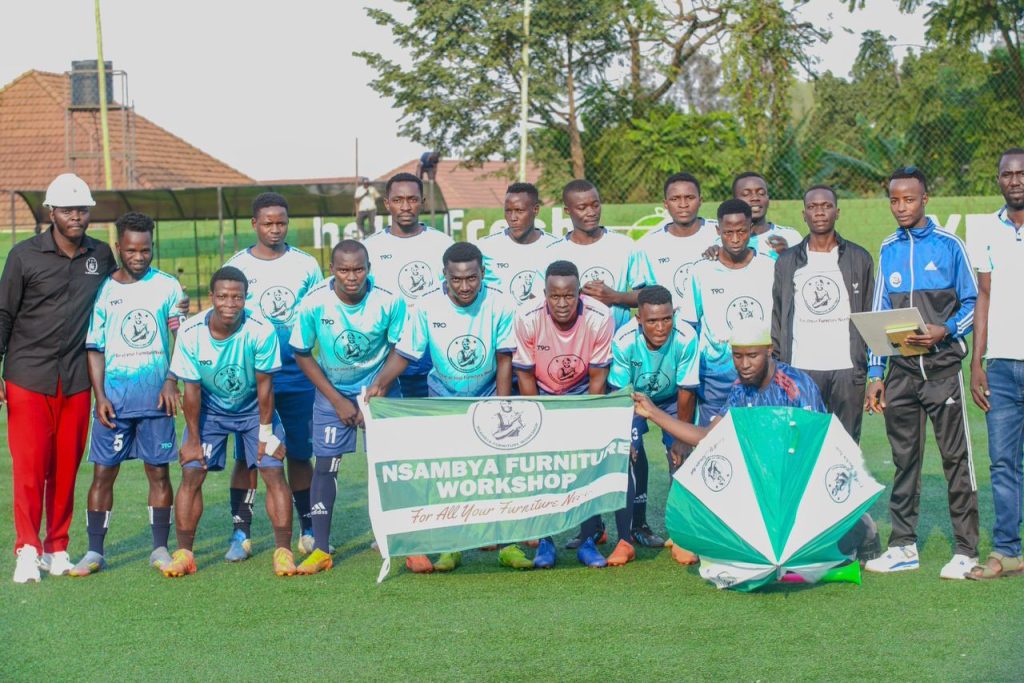In a display of tactical brilliance, athletic excellence, and sheer determination, Nsambya Furniture Workshop FC stamped their authority on the Kampala football scene with a commanding 5–0 victory over Tulibulala Family this past weekend. The match, held at a sun-soaked local stadium, was not merely a contest of skill—it was a statement of intent from a club increasingly recognized as a powerhouse in community football.
From the moment the referee blew the whistle, it was clear that Nsambya had come to dominate. Fans packed the stands, waving colorful banners, waving flags, and chanting in unison, creating an atmosphere that rivaled top-flight fixtures. Vendors hustled along the sidelines, children jostled for a glimpse of their heroes, and local media swarmed to capture every moment of what would become a memorable afternoon.
The Pre-Match Buzz
Leading up to the game, expectations were high. Nsambya Furniture Workshop FC, under the meticulous guidance of Ssegujja Ivan, CEO of Nsambya Furniture Workshop and club owner, had been steadily building a reputation for consistent performance, organization, and strategic precision. Tulibulala Family, while respected for their tenacity and spirited approach, were widely seen as the underdogs.
Community discussions, social media chatter, and local radio shows speculated on whether Tulibulala could resist Nsambya’s onslaught or whether the match would turn into a showcase for Nsambya’s growing dominance. The excitement was palpable, with many spectators arriving hours before kickoff, eager to witness the unfolding contest.
First Half: Nsambya Takes Command
The opening minutes were a study in control. Nsambya immediately pressed high, forcing Tulibulala into hurried clearances and disrupted play. The first goal came early following a sweeping move from midfield, sending the crowd into a frenzy.
Tulibulala attempted to respond with a compact defensive setup, trying to congest the midfield and slow Nsambya’s flowing attacks. For a brief period, their strategy created minor frustrations for Nsambya, but the balance of play remained overwhelmingly in favor of the visitors.
By the 28-minute mark, a perfectly executed set piece doubled Nsambya’s lead. Before halftime, a third goal, crafted from a rapid counterattack, cemented the message: Nsambya was in control, and there would be no easing up.
Halftime: Atmosphere and Reflection
At the break, the scoreline read 3–0, yet the energy in the stands remained electric. Fans sang club chants, waved flags, and cheered every passing move. Local vendors reported record sales as spectators purchased refreshments, jerseys, and memorabilia, turning the match into a festival of community spirit.
Tulibulala’s supporters, while visibly concerned about the unfolding result, maintained their loyalty, clapping and encouraging their team despite the scoreline. The halftime discussion among their squad centered on regrouping and attempting to salvage pride in the second half.
Second Half: Nsambya’s Relentless Efficiency
From the restart, Nsambya displayed renewed intensity. A long-range strike early in the second half brought the score to 4–0, an audacious effort that demonstrated both confidence and technical prowess. Tulibulala’s occasional counters were swiftly neutralized by Nsambya’s disciplined defense.
The fifth goal, a product of clever passing and composed finishing, arrived late in the game, capping off a dominant performance. By this stage, the atmosphere in the stadium had shifted from suspense to celebration, with fans chanting and singing in unison, proud of their team’s mastery.
Tactical Analysis: Why Nsambya Excelled
Several factors contributed to Nsambya’s comprehensive victory:
MmHigh Pressing: Constant pressure forced Tulibulala into errors and turnovers in critical areas.
Midfield Control: Rapid ball circulation stretched the opposition and dictated the pace of the game.
Clinical Finishing: Five clear chances converted into five goals, a testament to offensive efficiency.
Defensive Discipline: Rare Tulibulala attacks were consistently neutralized, preserving a clean sheet.
Tulibulala Family, despite their best efforts, struggled to retain possession, respond to the tempo, or create meaningful chances, underscoring the gap between preparation and execution on the day.
Leadership Beyond the Pitch
The triumph reflects more than just team skill—it is also the product of strong leadership. Ssegujja Ivan, as both entrepreneur and football club owner, brings a philosophy of discipline, structure, and vision to the team. His commitment ensures that Nsambya Furniture Workshop FC is professional not just in play but in preparation, strategy, and community engagement.
Complementing Ivan’s leadership is Mirembe Irene Nagawa, CEO of Mirembe Beddings & Curtains, whose initiatives in community support, media outreach, and youth engagement have strengthened the club’s broader influence. Together, the couple embodies a model where business leadership and sports management merge to create tangible social impact.
Fan and Community Impact
Football in Uganda is about more than just goals—it’s about identity, opportunity, and unity. Matches like this highlight the social and economic ripple effects: vendors benefit from increased business, families come together for entertainment, and young spectators are inspired to pursue sport or engage in community initiatives. Nsambya Furniture Workshop FC, through performances like this, has become a focal point for community pride and cohesion.
Lessons and Looking Forward
For Nsambya, the 5–0 victory is a foundation, not a conclusion. Maintaining consistency, hunger, and focus will be essential as the season progresses. Tulibulala Family, while humbled, have an opportunity to analyze weaknesses, improve cohesion, and emerge stronger in future fixtures.
Analysts have noted that grassroots clubs in Uganda can serve as incubators for talent, community engagement, and regional pride. Nsambya’s model, blending leadership, planning, and skill development, demonstrates the potential of such clubs to elevate both the sport and their communities.
Conclusion
Ultimately, the match was more than a scoreline—it was a demonstration of vision, leadership, and community spirit. Nsambya Furniture Workshop FC did not just win; they showcased what a well-led, disciplined, and ambitious grassroots football team can achieve.
For fans who left the stadium that day, voices hoarse from cheering and faces alight with joy, the memory of a 5–0 victory over Tulibulala Family will endure—a triumph that belonged not just to the team, but to the community, leadership, and vision that made it possible.

